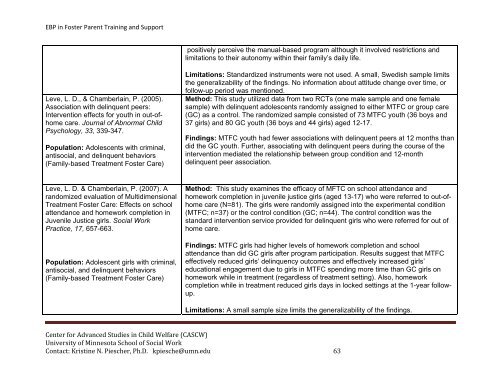Evidence-Based Practice in Foster Parent Training and Support ...
Evidence-Based Practice in Foster Parent Training and Support ...
Evidence-Based Practice in Foster Parent Training and Support ...
Create successful ePaper yourself
Turn your PDF publications into a flip-book with our unique Google optimized e-Paper software.
EBP <strong>in</strong> <strong>Foster</strong> <strong>Parent</strong> Tra<strong>in</strong><strong>in</strong>g <strong>and</strong> <strong>Support</strong>positively perceive the manual-based program although it <strong>in</strong>volved restrictions <strong>and</strong>limitations to their autonomy with<strong>in</strong> their family’s daily life.Leve, L. D., & Chamberla<strong>in</strong>, P. (2005).Association with del<strong>in</strong>quent peers:Intervention effects for youth <strong>in</strong> out-ofhomecare. Journal of Abnormal ChildPsychology, 33, 339-347.Population: Adolescents with crim<strong>in</strong>al,antisocial, <strong>and</strong> del<strong>in</strong>quent behaviors(Family-based Treatment <strong>Foster</strong> Care)Limitations: St<strong>and</strong>ardized <strong>in</strong>struments were not used. A small, Swedish sample limitsthe generalizability of the f<strong>in</strong>d<strong>in</strong>gs. No <strong>in</strong>formation about attitude change over time, orfollow-up period was mentioned.Method: This study utilized data from two RCTs (one male sample <strong>and</strong> one femalesample) with del<strong>in</strong>quent adolescents r<strong>and</strong>omly assigned to either MTFC or group care(GC) as a control. The r<strong>and</strong>omized sample consisted of 73 MTFC youth (36 boys <strong>and</strong>37 girls) <strong>and</strong> 80 GC youth (36 boys <strong>and</strong> 44 girls) aged 12-17.F<strong>in</strong>d<strong>in</strong>gs: MTFC youth had fewer associations with del<strong>in</strong>quent peers at 12 months th<strong>and</strong>id the GC youth. Further, associat<strong>in</strong>g with del<strong>in</strong>quent peers dur<strong>in</strong>g the course of the<strong>in</strong>tervention mediated the relationship between group condition <strong>and</strong> 12-monthdel<strong>in</strong>quent peer association.Leve, L. D. & Chamberla<strong>in</strong>, P. (2007). Ar<strong>and</strong>omized evaluation of MultidimensionalTreatment <strong>Foster</strong> Care: Effects on schoolattendance <strong>and</strong> homework completion <strong>in</strong>Juvenile Justice girls. Social Work<strong>Practice</strong>, 17, 657-663.Population: Adolescent girls with crim<strong>in</strong>al,antisocial, <strong>and</strong> del<strong>in</strong>quent behaviors(Family-based Treatment <strong>Foster</strong> Care)Method: This study exam<strong>in</strong>es the efficacy of MFTC on school attendance <strong>and</strong>homework completion <strong>in</strong> juvenile justice girls (aged 13-17) who were referred to out-ofhomecare (N=81). The girls were r<strong>and</strong>omly assigned <strong>in</strong>to the experimental condition(MTFC; n=37) or the control condition (GC; n=44). The control condition was thest<strong>and</strong>ard <strong>in</strong>tervention service provided for del<strong>in</strong>quent girls who were referred for out ofhome care.F<strong>in</strong>d<strong>in</strong>gs: MTFC girls had higher levels of homework completion <strong>and</strong> schoolattendance than did GC girls after program participation. Results suggest that MTFCeffectively reduced girls’ del<strong>in</strong>quency outcomes <strong>and</strong> effectively <strong>in</strong>creased girls’educational engagement due to girls <strong>in</strong> MTFC spend<strong>in</strong>g more time than GC girls onhomework while <strong>in</strong> treatment (regardless of treatment sett<strong>in</strong>g). Also, homeworkcompletion while <strong>in</strong> treatment reduced girls days <strong>in</strong> locked sett<strong>in</strong>gs at the 1-year followup.Limitations: A small sample size limits the generalizability of the f<strong>in</strong>d<strong>in</strong>gs.Center for Advanced Studies <strong>in</strong> Child Welfare (CASCW)University of M<strong>in</strong>nesota School of Social WorkContact: Krist<strong>in</strong>e N. Piescher, Ph.D. kpiesche@umn.edu 63
















